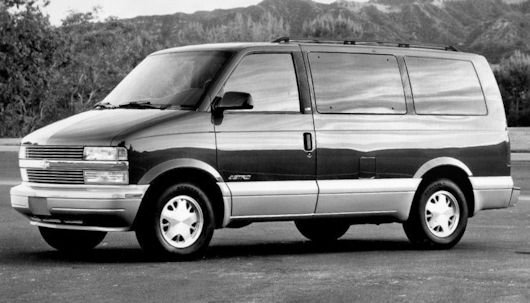Chevrolet Astro GMC Safari 2nd generation
 |
|
|
Production |
1995 to 2005 |
|
Class |
Commercial vehicle |
|
Related |
GMC Safari |
|
Engine |
4.3 L 190 hp (142 kW) V6 |
|
Wheelbase |
1995–96: 111.0 in (2,819 mm) |
|
Length |
189.8 in (4,821 mm) |
|
Width |
77.5 in (1,968 mm) |
|
Height |
1995–96 Astro: 75.9 in (1,928 mm) |
The Chevrolet Astro is a rear-wheel-drive van that Chevrolet introduced in 1985 as a rival to the Dodge Caravan and Plymouth Voyager from the US and the Japanese Toyota Van. The Astro was also sold as GMC Safari with another grille. In addition to the equipment for passenger transport, the two are also available as delivery vans. In addition, they served as the basis for customer-specific conversions.
History
In 1995, the model was given a facelift; it got a longer front end, which looked similar to the new Express. In 1996 there was again a new dashboard with passenger airbag. From then on, the vans remained stylistically unchanged until the cessation of production in 2005.
The Chevrolet Astro, based on the GM M platform, was also sold in Japan, where it became a cult vehicle, except in the US. In the last year, 2005, Chevrolet Japan offered a limited edition of. Although the car was only offered with left-hand drive, it still became so popular in Japan.
As GM's sales plummeted, the company closed several plants and discontinued low-volume models. With new technical standards for side-impact protection and passenger protection against head injuries, GM decided it would not make much sense to put a lot of money into reconstructing poorly saleable model ranges. Thus, the production of Astro and Safari was set on 13 May 2005 and the long-used plant in Baltimore, where the two had been produced, was closed. Astro and Safari were the only vans with rear-wheel drive which have been manufactured for more than 20 years - a much longer model cycle than that of its direct competitor Ford Aerostar, which was taken out of production in 1997. From 1998, when the original Mazda MPV was discontinued, Astro and Safari were the only rear-wheel drive vans available in the US and Canada. Altogether, the plant in Baltimore produced about 3.7 million astro and safari.
The Chevrolet Astro was replaced by the "Crossover" Uplander, which also served as the successor to the venture. Like the Astro, there was also the Uplander as a van and minibus. GMC presented the successor to the Safari 2007 Acadia.
As with the second-generation GM-F platform and GM-X platform vehicles, the Astro / Safari has a front-mounted subframe with the front suspension of the GM B platform from the Combi versions of the Chevrolet Caprice and Cadillac Brougham and rear leaf springs. The lower suspension joints are larger than those of the B-platform (e.g. the Fleetwood sedans). These joints were built in 1995/1996 also in the 9C1 police package for the Chevrolet Caprice. The cars also show many mechanical similarities with the GMT-325/350 pickups and delivery trucks.
As previously mentioned, Astro and Safari have standard rear-wheel drive, but in 1990 there was a whole new optional all-wheel drive, which by FF Developments (FFD) was constructed. The four-wheel drive consumes more fuel: it came to only 17 mpg (miles per gallon) versus 20 mpg. in the rear-wheel-drive van. Premature wear on the handlebars was a problem. There were hundreds of cases of torsion bar failure in the wheelbase of the four-wheel drive vehicles. The torsion bars failed without warning, which led to a sinking of the chassis. To repair both torsion bars had to be replaced with improved copies, which cost about 1000 US dollars. Deaths were not to be lamented.
In 2003, GM upgraded the Astro and Safari suspension with specific suspension components, larger brakes and 16 "wheels from the larger Chevrolet and GMC-0.5 trucks. These changes improved the driving and braking behaviour of the vans.
The IIHS (Insurance Institute for Highway Safety), which tests vehicles for safety, rated the 1996 Astro model year as "poor" as its entire vehicle structure collapsed against a fixed barrier during the 64km / h offset crash, The vehicle floor was deformed and pushed both front seats with the dummies forward into the dashboard and into the steering wheel.
Astro and Safari performed better in NHTSA (National Highway Traffic Safety Administration) tests. From a star in 1990, the car improved to 3 stars (driver), or 4 stars (passenger) in model year 1999. In the side impact test both vehicles arrived, from the date on which this was done, the highest rating of 5 stars.
In addition to their popularity for professional tuners, Astro and Safari were also popular with "backyard tuners". There are conversions for road and terrain. On some vans, the original 4.3-liter V6 engine was replaced with a 5.7-liter small-block V8 engine. This is simple because the 4.3L V6 engine on the engine is based on the small-block series, allowing most of the original powertrain components to continue to be used.
Because of its design based on a delivery van, the Astro is also used by site and camping friends. The combination of a powerful drive, a high passenger and cargo capacity, the all-wheel drive and an available optional locking differential for the rear axle facilitates the conversion to off-road use. The vehicle can be raised, allowing changes to the tires and ground clearance with relatively little change in appearance.
